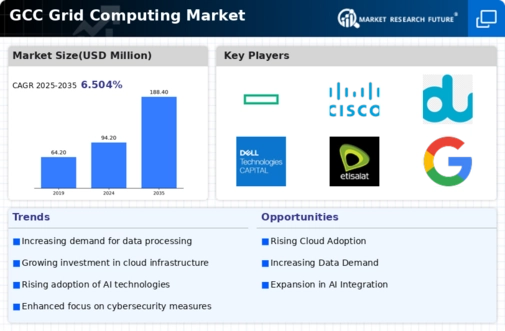The grid computing market is currently characterized by a dynamic competitive landscape, driven by rapid technological advancements and increasing demand for efficient data processing solutions. Key players such as IBM (US), Microsoft (US), and Amazon (US) are at the forefront, leveraging their extensive resources to innovate and expand their service offerings. IBM (US) has been focusing on enhancing its hybrid cloud capabilities, which appears to be a strategic move to cater to enterprises seeking flexible computing solutions. Meanwhile, Microsoft (US) emphasizes its Azure platform, integrating AI and machine learning to optimize grid computing applications, thereby positioning itself as a leader in digital transformation. Amazon (US), through its AWS division, continues to dominate the market by providing scalable and cost-effective grid solutions, which collectively shapes a competitive environment that is increasingly reliant on technological innovation and strategic partnerships.
In terms of business tactics, companies are increasingly localizing their operations to better serve regional markets, which may enhance supply chain efficiency and responsiveness. The market structure appears moderately fragmented, with several key players exerting substantial influence. This fragmentation allows for a variety of service offerings, yet the collective strength of major companies like IBM (US) and Microsoft (US) suggests a trend towards consolidation through strategic alliances and partnerships.
In October 2025, IBM (US) announced a collaboration with a leading telecommunications provider to develop a new grid computing framework aimed at enhancing network efficiency. This partnership is likely to bolster IBM's position in the telecommunications sector, enabling it to offer tailored solutions that address the unique challenges faced by telecom operators. Such strategic moves indicate a shift towards industry-specific applications of grid computing, which could redefine competitive dynamics.
In September 2025, Microsoft (US) unveiled a new initiative focused on sustainability within its Azure platform, aiming to reduce energy consumption by 30% in its data centers by 2026. This initiative not only aligns with global sustainability goals but also positions Microsoft as a responsible leader in the tech industry. The emphasis on sustainable practices may resonate well with environmentally conscious consumers and businesses, potentially enhancing customer loyalty and market share.
In August 2025, Amazon (US) expanded its AWS offerings by introducing a new grid computing service tailored for small and medium-sized enterprises (SMEs). This strategic expansion is significant as it opens new revenue streams and addresses the growing demand for accessible computing solutions among SMEs. By catering to this segment, Amazon is likely to strengthen its competitive edge and foster innovation within the grid computing space.
As of November 2025, current trends in the grid computing market are heavily influenced by digitalization, sustainability, and the integration of AI technologies. Strategic alliances are increasingly shaping the competitive landscape, as companies recognize the value of collaboration in driving innovation. Looking ahead, it appears that competitive differentiation will evolve from traditional price-based strategies to a focus on technological innovation, reliability in supply chains, and sustainable practices. This shift may redefine how companies compete, emphasizing the importance of adaptability and forward-thinking in a rapidly changing market.

















Leave a Comment